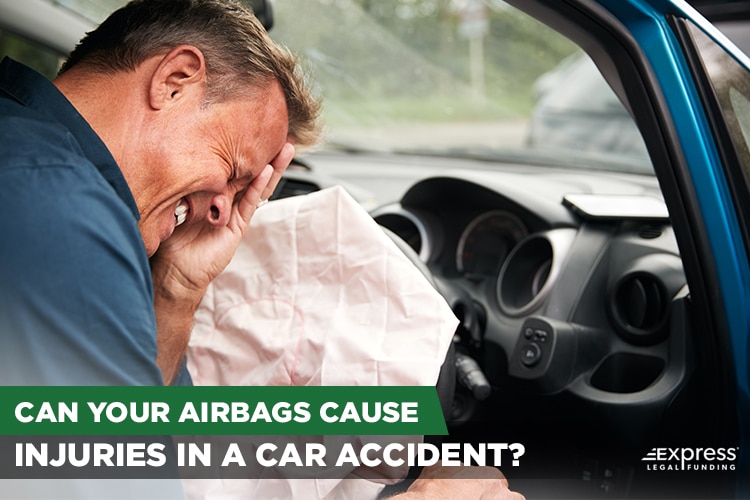
Motor vehicle accidents are widespread, which is unfortunate, given how reliant we have become on motorized transportation.
Despite the convenience that cars and trucks provide, they are extremely dangerous and must be operated carefully to avoid car crashes that can injure yourself or others.
The scenario and location of a car accident can make things more complicated and deadly, such as multiple cars colliding in chain-reaction car crashes and cars sinking in water after getting rear-ended (the focus of this article).
A car plunging into a body of water (a river, lake, or ocean) can be an extra devastating and deadly scenario, as the car can quickly sink to the bottom with the occupants stuck inside.
Continue reading to learn about the ins and outs of car accidents involving cars sinking in water, including what to do if you find yourself in this harrowing situation and your legal options.
How Does Water Affect a Car Accident?
While it could certainly be categorized as rare, a car accident can cause a vehicle to end up in a body of water. You may have even seen one already on your local news channel or breaking news on CBS, NBC, or your favorite news app.
Motor vehicle accidents can be intense and cause the vehicles involved to travel further from the force of the collision.
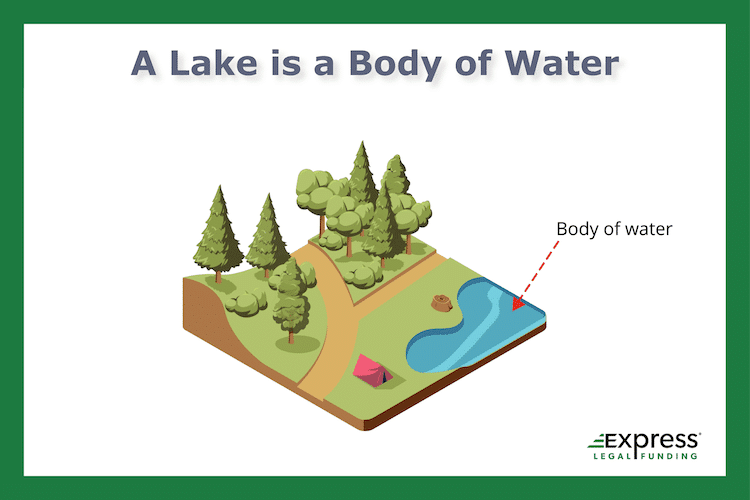
Essentially, Isaac Newton’s laws of motion are not suspended just because you happen to be in a car.
If the vehicle that hits yours is heavier or moving faster than yours, the force it generates when it hits yours could send your vehicle forward. This is further exacerbated if you instinctively slam down on the gas pedal or countersteer out of reflex, which has been known to happen.
This situation can be disastrous when driving along a road since you could crash into another vehicle or nearby structures.
However, the problem is significantly worse in areas with substantial water.
If the accident is severe enough to cause your vehicle to veer off the road and toward the water, you could end up in a submerged car, which is incredibly dangerous.
High Risk of Drowning in Sinking Cars
There is a high likelihood that a vehicle sinking underwater will likely cause you to drown despite being seatbelted in your car when the car crashes into the water.
That is because cars are not watertight (even with closed car doors and rolled-up windows ), and water will eventually flood the vehicle’s interior. The deeper the vehicle submerges below the surface, the faster it will flood, and it becomes next to impossible to open the doors and swim to an escape.
It’s a concept of science that makes escaping a sinking car or truck increasingly difficult the deeper it submerges underwater.
The more feet down a car sinks, the higher the amount of water pressure pushing against the exterior and doors.
Can You Open a Car Door Underwater?
The water will exert pressure on the car doors, equivalent to 600 pounds per square inch. As a result of this pressure, it is virtually impossible to open the door of a vehicle until it is completely submerged underwater and the pressure equalizes between the outside and the interior of your car.
However, to escape without drowning, you should not wait for the pressure to balance, as that means your car will already be filled with water, and you no longer have oxygen to breathe.

Additionally, the ability to exit the vehicle might not be available if the collision caused you to hit your head and render you unconscious.
The latter situation makes escape unlikely unless a bystander helps you or you regain consciousness before the car floods. While it is an unnerving thought, it is essential to understand the severity of being in a submerged car.
Additionally, it is worth learning how to escape a submerged or sinking car to maximize your chances of survival.
How to Escape a Sinking Car?
Escaping a sinking vehicle can be challenging since most people start panicking and try to escape and avoid drowning in the wrong way by attempting to open a car door.
Unfortunately, taking incorrect measures in the moments following your car crashing into the water will exacerbate your panic, which in turn raises the odds of drowning.
By staying calm, you give yourself the best chance to not get trapped and have you and your fellow car occupants successfully escape before it is too late.
That said, you must do what you can to avoid this situation entirely.
Having to wait for the inside of your car to fill up with water before you even have a shot at opening one of the doors of your submerged car is a barely viable option.
Fortunately, there are better alternatives that you can use to escape a sinking car. However, it remains a very precarious situation where you must move quickly yet be mindful to exercise caution each step of the way.
That is why we created the following guide of what to do and what not to do if you are in a crashed car sinking in water.
What Safety Precautions Should You Take While Driving Near Water?
For starters, taking preventative measures ahead of time is a great way to reduce the chance of needing to escape a sinking car. Some preventable measures you can take to help you never be in the situation of your car crashing into the water include the following:
- Follow the traffic laws and adhere to the rules of the road, such as not going over the speed limit, signaling a lane change, and keeping your headlights on while driving during dawn or dusk, all of which help you not get in a car accident.
- Be wary of other drivers when near a body of water, such as crossing a bridge or on the side of a mountain next to the ocean, especially since these locations often include tight roads and are more difficult to navigate.

Like any dangerous circumstance where you must make crucial life or death decisions on the fly and do not have time to spend even just a few minutes to evaluate your best course of action, there are certain things you should do and others that you should not do.
So we will start with our list of what you should do if you get in a crash that forces your car into the water.
What to Do if Your Car is Sinking in Water?
The following includes some of the most critical actions you may need to take to safely get out of a sinking car and swim to land.
Roll down Car Windows
Once your car begins to submerge, quickly roll down all of your vehicle’s windows before your car fully submerges. Doing this lets you swim immediately to the surface by exiting your car through the side windows.
Further, if they are power windows that you can raise and lower with the push of a button, there is a good chance you can still open the windows for a few minutes even after your car sinks below the water’s surface. The power function should stay operational for a few minutes.
Keep Hands at the 10 and 2 Positions on the Steering Wheel
If you are the driver, you should keep your hands on the steering wheel in the 10 and 2 positions before the car impacts the water’s surface to protect your arms and shoulders in case of steering wheel airbag deployment.
This airbag injury risk is only for the driver as the airbags installed in modern cars to protect the passengers do not pose this risk.
Unfasten Seatbelts After Impact
Once your car collides with the surface of a body of water, you should attempt to unfasten your seatbelt buckle, which enables you to move freely about the interior of the car and then attempt to escape.
You should unbuckle yourself and the passengers before opening any windows since opening a window causes water to rush in and fill your car, taking away the air supply you still have left.
Break Side Windows to Escape
If you cannot roll down your side window, you need to break the glass to provide you an escape route out of the sinking car so you can swim to the surface.
How to Break a Car Window Underwater?
The best way to break a car window underwater is by purchasing and driving with a car safety glass breaker designed to break the tempered glass in car windows.
The optimal location where you should hit the side window to break it is at the bottom corner closest to the hinges, as the spot is weaker and easier to break than the window’s center.
You can use the below infographic for reference.
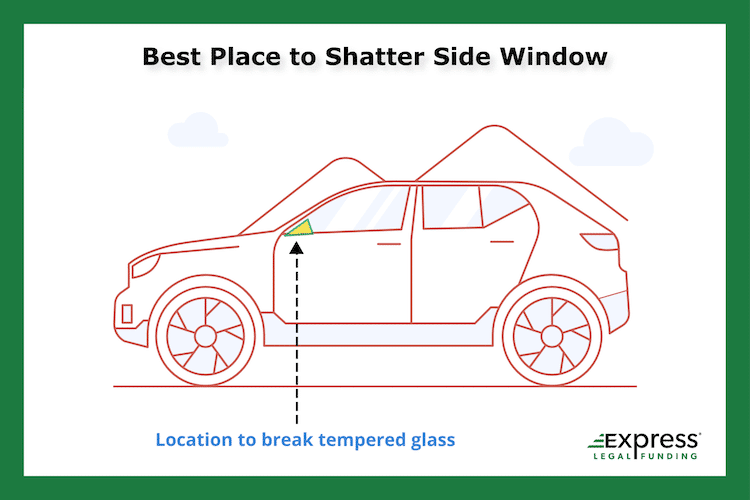
Call the Authorities
Once you reach the surface and find your way to dry land or a structure you can hold onto, you should dial 911, as getting medical attention is especially critical after surviving a car accident that involves escaping a sinking vehicle.
Your body will have produced adrenaline to help you power through the fight or flight situation, making you less likely to feel pain and realize you have injuries due to the crash.
Remove Your Wet Clothes and Huddle Together if the Water is Cold
If the water your car fell into and you had to swim to escape is a low temperature, you are at risk of developing hyperthermia, which can be fatal.
So to warm your body up to a safer temperature and avoid hyperthermia, you should remove all of your wet articles of clothing and huddle together to warm each other up with your body heat.
What Not to Do if Your Car is Sinking in Water?

The following includes some things it is crucial you avoid doing when your call falls into the water and you are trapped inside.
Do Not Take Your Seatbelt Off Before You Hit the Water
The reason you should not unbuckle your seatbelt prior to impact with the water’s surface is the same reason you should wear a seatbelt while driving (It is legally required to wear a seatbelt in all states except for New Hampshire).
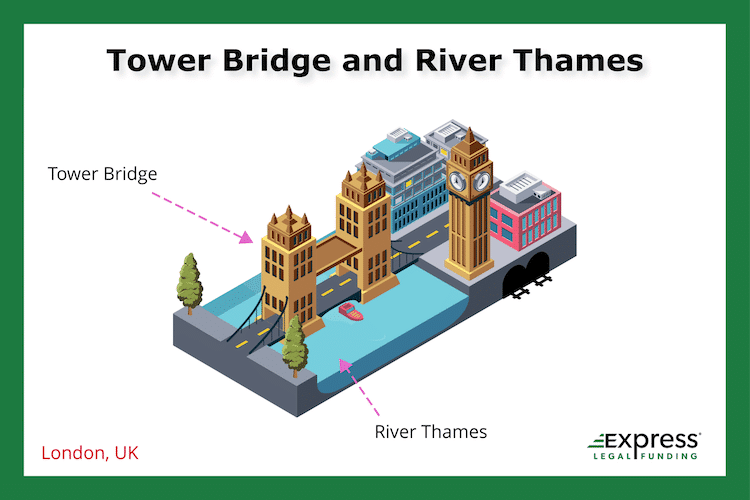
Example Scenario:
After you get hit by another driver on a bridge, your car slowly begins to tip off the side before it falls into a river below.
In this example, you should not take the few moments you have before your car falls into the water to remove your seatbelt.
Being buckled keeps you from lifting from your seat and slamming against the car’s interior, which can lead to your hitting your head and losing consciousness and, therefore, more likely to drown before you can wake up.
Passengers Should Not Attempt to Brace themselves.
The non-driver occupants of the vehicle should not brace themselves, anticipating the collision with the water below them, as it increases the chance they will suffer injuries to their extremities, such as breaking or spraining their wrists.
Do Not Unbuckle Children Before Yourself
Similar to how you should put an oxygen mask on yourself before your child on an airplane if the cabin pressure destabilizes, so too is the case that adults should attempt to unfasten their seatbelts prior to unbuckling any children’s seatbelts when a car is sinking in water.
By parents unbuckling their seatbelts first, they are able to be most effective when they work to help their family escape a vehicle that is flooding with water.
Do Not Exit Sunken Car Before Children
Although adults should unbuckle first before helping children, they help children exit the underwater vehicle before they do.
Having the children who can swim exit the sinking car first to swim to the surface allows adults to make sure the children do not get left behind.
Also, children cannot hold their breath underwater as adults, so it is imperative to have them get to the surface and access oxygen before adults.
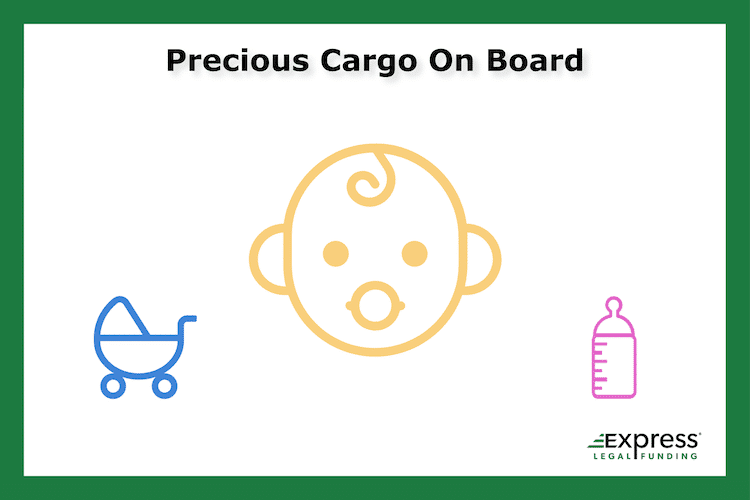
However, infants can hold their breath underwater longer than other children and adults due to a survival response of babies lowering their heart rate to conserve oxygen.
How to Escape a Sinking Car With a Baby?
Adults should not expect a baby or toddler to swim or float their way up to the surface from a sunken car unaccompanied. Instead, adults should hold onto them while they swim to the surface together.
Do Not Attempt to Break the Windshield to Escape
Manufacturers of modern-day cars use laminated glass for the windshields, which offers extra protection in contrast to tempered glass used in most side windows.
Due to the strength of laminated glass, it is futile for you to try to break or kick the windshield out.
Do Not Try to Take Belongings
It is understandable that you will want to gather your belongings before exiting the sinking vehicle.
However, you should not attempt to bring any belongings to the surface other than a cell phone (if you can quickly access it and keep it on your body, i.e., in your pocket).
After surviving a motor vehicle crash into the water, not only is it understandable if you feel anxious and traumatized it is to be expected, to say the least.
While escaping and surviving a sinking motor vehicle physically unharmed is the best-case scenario, the chance of you not having injuries and your car or truck being salvageable is next to none.
So the question is, what can you do from a legal recourse perspective about your injuries and loss of your vehicle if the crash situation was caused by someone else hitting you?
Filing a Lawsuit if Your Car Falls in Water
The law has no special provisions concerning car accidents that lead to the vehicle being submerged. Nonetheless, they are car accidents, and car accident victims can file lawsuits against the responsible party to recover from the accident’s financial damages.
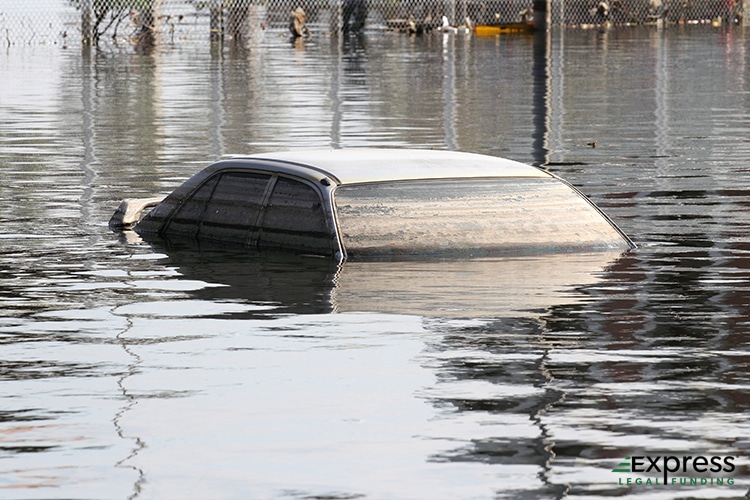
One of the most common civil claims in America and across the world are personal injury claims that victims of injuries file to recover from the financial loss of the accident.
Motor vehicle collisions are also one of the most common causes behind personal injury claims because they are so widespread.
Typically, a personal injury claim over a car wreck has nothing to do with water and focuses solely on the situation on the road. Unfortunately, motor vehicle accidents can happen anywhere, and ending up in a body of water is a possible scenario worthy of a claim.
Fortunately, car accidents involving bodies of water do not alter the process, and filing a claim is the same as it is for accidents on land. The main issue with a personal injury claim over a motor vehicle collision is proving someone else was at fault.
In contrast to city street and highway car crashes, proving fault can be more challenging for car accident cases that involve bodies of water.
That is because accidents on city streets and even neighborhood roads often benefit from the presence of bystanders and well-positioned traffic cameras.
Hire a Personal Injury or Drowning Accident Attorney
An attorney and law firm can help you prove fault, as they have the experience and financial resources to research your case and identify critical forms of evidence they can use against the defense.
Evidence From Property Damage to Car
Your lawyer can use photo evidence from the accident scene and point to the car’s physical damage (location of dents) to prove the other party is liable for causing the wreck that made your car plunge into and sink into a body of water.

When your car plunges into a body of water, there is a delay between the accident and exiting your vehicle to address the other motorist.
Fortunately, there are ways of proving your vehicle was damaged by another by comparing the indentations on the cars.
Furthermore, there is always a chance that another vehicle will pass by at the time of the accident, providing a witness.
Ultimately, proving fault will likely be the most challenging part of the claim since the at-fault driver might attempt to avoid responsibility.
Still, more often than not, personal injury claims end favorably, but you should consider hiring an attorney to represent you and give you legal advice to best ensure you get compensated for your loss.
In addition to the at-fault driver being liable for the injuries you sustained from the initial collision, it is also the other driver’s financial responsibility for what you suffered while escaping the sinking vehicle.
The presence of water does not hurt your injury claim or absolve the liable party from being held accountable for the sinking car part of the collision situation. You will have medical expenses and treatment costs that you don’t want to be on the hook for paying.
Types of Sinking Car Crash Injuries
Although most of the injuries typically sustained from escaping a sinking vehicle are superficial, some circumstances could lead to serious injury.
The more severe types of personal injuries often require you to receive intensive medical care to treat them, which can include the following:
- Traumatic brain injury (TBI)
- Cervical spine and spinal cord injuries
- Internal bleeding
- Bone fractures
Also, you will likely require therapy to process and work through the mental and emotional trauma you are dealing with after your car crashes into the water and nearly drowning.
The monetary cost of your medical care and treatment plans play a significant role in why you will need to file a claim in the first place.
Both proving fault and the financial loss you are dealing with that is caused by the accident are details that directly affect the compensation you can expect to recover once your case is resolved.
What Do You Stand to Gain from the sinking car accident lawsuit?
Like all personal injury claims, the main goal of filing a lawsuit for a crash that caused your car to sink into water is to ensure the at-fault driver (or their insurance company) is held financially accountable for the actions made against you, which caused you harm.

Car Accident Settlement or Award of the Court?
Typically, there are two forms of compensation of which you can receive money when you file a personal injury claim:
- Settlement – is an out-of-court agreement reached between two or more parties. In the case of a car accident involving a sinking car, the settlement will include money to reimburse you for the cost of medical bills, pain and suffering, the replacement value of your car, etc.
- Trial award – is a court-awarded settlement in which a jury or judge (if it’s a bench trial) orders the defendant to financially compensate the plaintiff for the damage caused to them.
Personal injury claims are designed to secure settlements from the at-fault driver’s insurance company to compensate for damages. One of the main factors contributing to the settlement of a motor vehicle claim is the status of your car.
In a best-case scenario, the vehicle’s damage is minor enough to be repaired. The settlement would be designed to provide you with the funds needed to finance those repairs since you were not responsible for the damage.
In worst-case scenarios, the car is totaled and must be replaced since a repair is impossible. The caveat is that these two situations are applied to accidents on normal roads.
When is a Car Considered Totaled?
When a vehicle ends up submerged in water because of an accident, it is always classified as “totaled” and, therefore, unsalvageable since it will cost more to fix it than replace it.
As a result, the owner of an underwater vehicle will need to find a replacement for the car since the vehicle is a total loss and cannot be repaired.
Fortunately, the settlement will account for financial loss, which includes the money to purchase a similar replacement vehicle. Usually, the settlement will offer an amount equivalent to the vehicle’s estimated value at the time of the incident (make, model, year, and mileage).
The settlement for the lost vehicle is separate from the settlement for the medical expenses you incurred because of the accident. The sunken car accident settlement involves the at-fault driver’s insurance company purchasing the wrecked vehicle from you.
The medical settlement is a separate adjuster’s responsibility and focuses on ensuring you have the funds necessary to pay off most, if not all, of your medical expenses.
Closing Statements on Cars Accidents in Water
Being involved in a car accident is stressful enough, but an accident where your vehicle is submerged is even more terrifying.
A near-death scenario can cause a traumatic response that can factor into certain damages reflected in a settlement.
Unfortunately, no laws mandate special privileges or compensation due to a submerged vehicle. Ultimately, the process is identical to a typical car accident, except for the car always being deemed “totaled.”
The more significant concern is that your daily expenses are not suspended when you file a lawsuit despite your incurring additional medical expenses.
We at Express Legal Funding know that when you have to file a car accident lawsuit, it means you have been thrust into a financially challenging situation at no fault of your own.
Further, the issue can be compounded because it could be months or even years before you receive your settlement, depending on the circumstances.
Motor Vehicle Accident (MVA) Pre-settlement Funding
For circumstances like these, Express Legal Funding can help.
For plaintiffs who are waiting for their cases to settle, we can offer pre-settlement funding so they can access the cash they need now, rather than having to wait until after their case ends to recoup any funds.
What makes the legal funding money we can provide unique, which is also how it works, is that it is specially designed for people who are suing another party for injuries and damages. Specifically, it is not a loan product.
Non-Recourse and Not a Loan
Instead, it is a non-recourse funding agreement between the client, who gets the pre-settlement money advanced to them, and us, the legal funding company.
What this means for you is that by the lawsuit funding company providing you funds before your case is settled or won, they are doing so by purchasing a stake in your potential case proceeds.
When a lawsuit funding company evaluates the strength and value of your case, it can “invest” in your case’s potential proceeds by advancing you a portion of your projected settlement funds.
Once your case settles, the legal funding company will receive the payout it is owed since it initially advanced funding to the client.

Just like no investment is guaranteed, the case for pre-settlement funding is tied to your case’s financial outcome.
This is what makes it risk-free for plaintiffs and why you don’t have to pay back any of the funds you received from us if you and your lawyer gave your claim your best shot but, unfortunately, are unsuccessful and do not recover any money at the end.
So, if you have an ongoing claim and need access to money to help you pay your bills and make new purchases, give us a call or apply online with an easy application contact form anytime, 24/7.
We are here to answer your call and help you move forward financially.
As always, we hope you found this a helpful resource. If you want to learn more about pre-settlement funding and the different types of lawsuits you can file, don’t hesitate to read more of the blog articles on our site.
(Missouri consumers: Please be aware that the type of pre-settlement financing we can provide to injured and damaged claimants in Missouri are recourse loans.
Therefore, they are not risk-free cash advances contingent upon a potential settlement or jury-awarded proceeds.
Lawsuit loans and car accident loans in states like Missouri are recourse loans and must, technically, by law, be repaid. Express Legal Funding-Missouri, LLC is a loan company licensed to give these loans in MO.)


![[Guide] Why Your Ears Are Ringing After a Car Accident Injury's featured image](https://expresslegalfunding.com/wp-content/uploads/2023/06/Ears-Ringing-After-a-Car-Accident.jpg)
